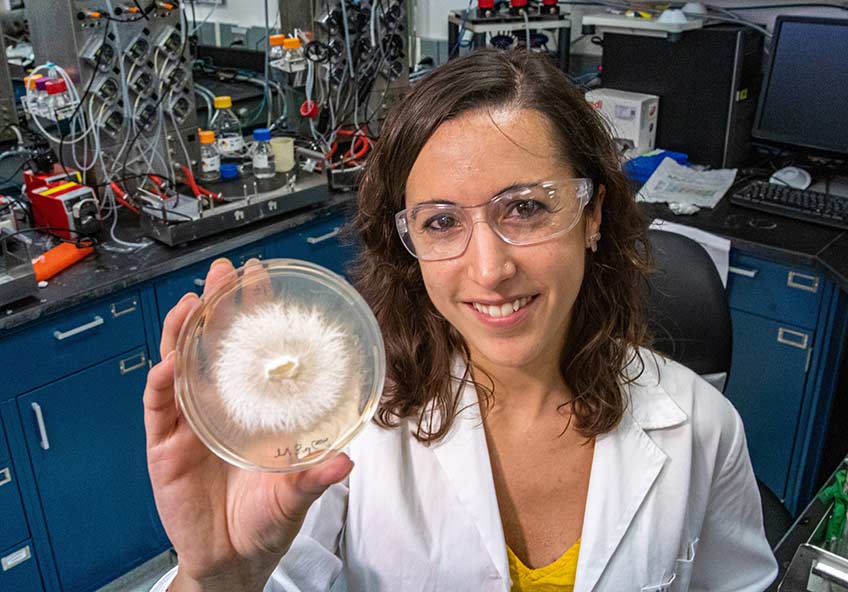The Role Fungi Will Play in NREL's Biomass Research
There’s no doubt Davinia Salvachúa Rodriguez’s career at the National Renewable Energy Laboratory (NREL) is mushrooming. The newly announced recipient of a prestigious research grant, Salvachúa will be awarded additional funds to explore the inner workings of white-rot fungi.

“Ever since I was 3 years old, I would go with my family to pick up white-rot fungi,” she said. “The one I love to eat is the oyster mushroom. That’s actually a white-rot fungi I’m going to be working on in my project.”
The federal Office of Science’s Early Career Research Program is investing $2.5 million in Salvachúa’s project, called “Elucidating Aromatic Catabolic Pathways in White-Rot Fungi during Lignin Decay.” The funds will be awarded over five years.
“I am so happy,” she said. “This is unbelievable.”
Now in its 10th year, the Early Career Research Program previously honored only two researchers from NREL: Kirstin Alberi and Adele Tamboli. This year, in addition to Salvachúa, the Office of Science selected Cara Lubner and Andriy Zakutayev as awardees. The Office of Science, in the Department of Energy (DOE), limits the funding opportunity to a researcher who has received a Ph.D. within the past 10 years.
Researchers may apply to one of six Office of Science program offices. Salvachúa is the first at NREL to receive early career funding through the Biological and Environmental Research program.
A researcher within the National Bioenergy Center at NREL, Salvachúa joined the laboratory in early 2014. The native of Spain earned a Ph.D. in microbiology the year before from the Universidad Complutense de Madrid, located about two hours away from her hometown. She has 10 years of experience working with both white-rot fungi and lignin.
Her research will attempt to solve the mystery of what really happens when white-rot fungi -- the best lignin degraders in nature -- meet lignin. What’s widely known is that the fungi digests lignin, which is contained in the cell walls of plants. The other parts of plants (i.e. cellulose) can be chemically and biologically converted to other uses, such as for biofuels and bioproducts, but lignin has proven to be a challenge. Despite decades of research, the mechanism of how fungi are able to metabolize lignin has not yet been explained.
White-rot fungi produce enzymes that break down lignin to carbon dioxide and water. However, it’s still undetermined whether the fungi use the products that come from lignin degradation, but Salvachúa hypothesizes that they do. Earlier research she conducted at NREL as principal investigator under a Laboratory Directed Research and Development (LDRD) project, which helped provide key data for the early career grant proposal, demonstrated varieties of the fungi were using lignin as a source of both carbon and energy.
“This is opening another door to basic research,” Salvachúa said. “Once we discover what’s happening inside these organisms, the next question is can we genetically modify them? Today we cannot engineer white-rot fungi, unlike many bacteria, which we do every day at NREL. That’s why it’s super challenging to work with these. In fact, with bacteria, you can do an experiment in one day. With white-rot fungi, it takes a month and a half for a single experiment. So, you need to have a lot of patience to experiment with these organisms.”
Salvachúa said in one experiment conducted at NREL, the fungi utilized 20% of lignin from poplar wood after 28 days. Genetic modifications could speed up the process and eventually, convert lignin into bioproducts.
“Davinia’s work on white-rot fungi has the potential to make great strides in our goals of effectively utilizing lignin for the production of bioproducts,” said Thomas Foust, director of the National Bioenergy Center.
Salvachúa also recently was named winner of the Young Investigator Award by the Society for Industrial Microbiology and Biotechnology (SIMB). The annual award is open to society members who are 35 years old or younger and intended to encourage young researchers to continue their work and to support their efforts. The society singled Salvachúa out “for significant research contributions in industrial microbiology or biotechnology which indicate promise of a professional career of merit.”
Last Updated May 28, 2025
